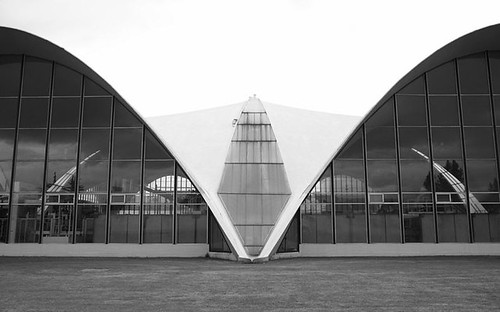Reusing existing buildings has many potential benefits, but might constructing new buildings offer greater life-cycle environmental advantages?
Read more...
Author: Mark Webster; Contributors: Adam Slivers, Matthew Comber
Reusing existing buildings instead of constructing new
buildings has many potential benefits, including:
- Reducing the use of new materials and their associated environmental impacts by extending the lifetime of materials that have already been manufactured and are in use.
- Protecting undeveloped land by reducing the pressure to construct new buildings and infrastructure on it.
- Reducing construction and demolition waste.
- Maintaining the cultural heritage of our existing building stock.
But even so, might constructing new buildings offer
life-cycle environmental benefits compared to reusing existing buildings? What
if new buildings are more energy efficient than the alternative reused
buildings?
Let’s look at three studies, summarized in Table 1, that use
life-cycle assessment methodology to compare building reuse to new
construction. These studies show much depends on assumptions regarding
operational energy use and lifespan.
Empty Homes Agency
The British Empty Homes Agency, a charity working to fill
unoccupied homes, compared the global warming impacts of three refurbished
homes to three new homes over a 50-year time period [EHA 2008]. All six case
studies are actual projects, so the embodied impact estimates are based on
actual bills of material. The authors selected the 50-year time period as the
assumed time between major refurbishments.
The average CO2 emissions over 50 years are 155
kg/ft2 of floor area for the new construction and 150 kg/ft2 for the rehabilitation
projects. If the authors had selected a 75-year time-frame, the results would
have been similar (211 vs. 219 kg/ft2). While the reused homes use more energy
per square foot per year (an average of 2.76 vs. 2.23 kg/sf/yr), the embodied
impacts are so much lower that at the end of the 50-year or even the 75-year
time-frames the differences in total emissions are small.
Athena Sustainable
Materials Institute
The Athena Sustainable Materials Institute (ASMI) conducted
a study for Parks Canada of four actual rehabilitation projects [ASMI 2009]. ASMI
compared the energy use and carbon emissions for the four buildings to the
impacts of demolishing the buildings and constructing similar new buildings.
Unfortunately the authors did not attempt to quantify the embodied impacts
associated with renovation of the existing buildings.
For the base case, which assumes the new buildings meet the
Canadian energy code, the average CO2 emissions for the new and
rehabilitated buildings over a 50-year period are almost identical: 251 kg/ft2
for the rehabilitated buildings vs. 253 kg/ft2 for the new buildings. Only the
existing Winnipeg building had better energy performance than the assumed new
replacement building; the assumed new buildings had lower energy use in the
remaining three cases.
Preservation Green
Lab
The Preservation Green Lab (PGL) of the National Trust for
Historic Preservation conducted the largest and most thoroughly documented
study comparing reuse and new construction. The
Greenest Building: Quantifying the Environmental Value of Building Reuse
examines the life-cycle impacts of seven reuse vs. new construction scenarios
in four different cities [PGL 2011]. The study’s findings are exceptionally
well documented and available for public scrutiny on the organization’s
website.
The PGL assumed for the new construction scenarios that the
existing building was demolished and includes the demolition impacts in the LCA
results. The PGL used actual renovation projects to estimate the embodied
impacts of renovation activities. The study quantifies 17 environmental
impacts, including climate change.
For its base case, PGL assumed that both the reuse and new
construction options have equal energy consumption. To evaluate the possibility
that the new construction options may be more energy efficient than the reuse
options, PGL also compared the reuse vs. new cases assuming 30% less energy use
in the new buildings. While PGL used a 75-year time-frame for its base case, it
also looked at time-frames ranging from 1 to 100 years.
Looking at just the commercial office building and
single-family residence analyses in Chicago and Portland:
- If the reuse and new options have equal energy consumption, the 50-year CO2 impacts are 12% to 17% less for the reuse option.
- If the new options are 30% more energy efficient than the reuse options, the 50-year CO2 impacts are 1% to 12% less than the new options. In other words, even assuming significantly better energy performance for the new options, the differences in climate change impact over 50 years are relatively small. Over a 75-year time-frame, the 30% more energy-efficient new buildings emit 5% to 16% less carbon than the less efficient reused buildings.
Discussion and Conclusions
The three studies were conducted or commissioned by entities
that generally support building reuse. Nevertheless, the studies appear to be
well planned and conducted. The usefulness of the Athena study is limited by
its neglect of the embodied impacts of the existing building renovations. Many
existing buildings will require significant upgrades to make them as energy
efficient as new construction, and the embodied impacts of these upgrades
should be considered. The PGL study found that the materials-related carbon
emissions for the rehabilitated office building, for example, accounted for 12%
of the total life-cycle emissions over 50 years, compared to 22% for the new construction.
The studies generally support the conclusion that over a
50-year life cycle, the environmental impacts of reuse are less than the
impacts of new construction when use-phase energy consumption is similar in the
two options (Figure 1). Even when the new construction options have
significantly better energy efficiency, the differences in life-cycle impacts
are not that large in many cases, and fall within the expected range of
uncertainty associated with life-cycle assessment studies.
Because the outcome of new vs. reuse comparisons depends
upon so many variables, readers are encouraged to make use of readily available
LCA tools and utility data to make their own project-specific assessments. The
Athena Environmental Impact Estimator and the U.S. Energy Information Administration
(EIA) are good starting points.
Timing
Of importance for climate change is the timing of the carbon
emissions (Figure 2). New construction generally releases more carbon emissions
than rehabilitation at the start of the life-cycle. Even in cases where the new
construction uses less energy, it can take many decades for the new buildings
to “pay back” that investment and equalize their emissions with the reuse
alternatives. If the new and reuse options have similar energy efficiency, that
pay-back may never happen. Those construction-related near-term emissions have
a more serious impact on climate change than the emissions that occur farther
in the future. Q3 also discusses this.
Beyond the Property
Line
None of the studies attempt to quantify reuse benefits that
occur beyond the building footprint. Existing buildings are more likely to be
in existing neighborhoods with existing infrastructure, such as water, sewer,
gas, and electricity. New buildings are often constructed on greenfield sites
where these utilities must be constructed to service the buildings.
Furthermore, I expect that existing buildings are more likely to be served by
public transportation than new buildings, and more likely to be in denser
neighborhoods. Therefore the daily users of these reused buildings may not have
to travel as far to reach them and may have more alternative transportation
options. A valuable research project would be to quantify these non-building
impacts associated with the reuse vs. new construction alternatives. I expect
the results would strengthen the argument that reuse is often environmentally
preferable.
| References |
Athena Sustainable Materials Institute (2009). A Life
Cycle Assessment Study of Embodied Effects for Existing Historic Buildings,
prepared for Parks Canada in association with Morrison Hershfield Limited (http://www.athenasmi.org/wp-content/uploads/2012/01/Athena_LCA_for_Existing_Historic_Buildings.pdf).
Empty Homes Agency (2008). New Tricks with Old Bricks:
How Reusing Old Buildings Can Cut Carbon Emissions (http://www.emptyhomes.com/empty-homes-publications-and-toolkits/empty-homes-publications/).
Preservation Green Lab (2011). The Greenest Building:
Quantifying the Environmental Value of Building Reuse (http://www.preservationnation.org/information-center/sustainable-communities/green-lab/lca/The_Greenest_Building_lowres.pdf).
|

















